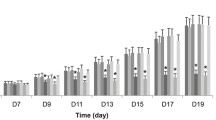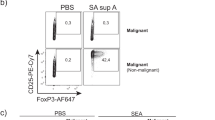Abstract
Human and murine squamous cell carcinomas (SCC) have been reported to produce proinflammatory cytokines IL-1a, IL-6, GM-CSF, and IL-8 or KC. Production of individual members of the proinflammatory cytokine family has been associated with increased tumor growth or metastasis in a variety of neoplasms. In this study, we determined whether the expression of these cytokines occurs as a result of the events of cel-lular transformation or culture, or is promoted by interaction of neoplastic cells with factors or cells in the host environment. We compared the expression of proinflammatory cytokines following the spontaneous transformation of murine keratinocytes in vitro, and following the formation of tumors and metastases from these transformed keratinocytes in syngeneic recipients in vivo. Using sensitive ELISA assays, we found that cultures of the in vitro transformed Balb/c SCC line Pam 212 do not produce elevated levels of proinflam-matory cytokines IL-1a, IL-6, GM-CSF and KC, indicating that transformation or culture alone is insufficient to account for the level of cytokine expression detected in patient and experimental tumors. In contrast, Pam reisolates from primary and metastatic tumors were obtained which constitutively produce markedly elevated levels of cytokines IL-1a, IL-6, KC and GM-CSF. The increase in the expression of these cytokines by SCC in vivo occurred independent of T and B lymphocyte-mediated immunity, since increases in expression of the cytokines was observed in lines reisolated from immunodeficient athymic nude and SCID Balb/c congenic mice. The increased expression of cytokines appeared to result from additional events in vivo, rather than due to selection of a pre-existing cytokine-producing subpopulation, since clones of the parental cell line expressed lower cytokine levels than cloned reisolates, and clones of the non-secreting parental cell line that formed tumors in vivo secreted elevated levels of cytokines following reisolation. We conclude that the development of SCC that express proinflammatory cytokines is promoted by tumor-host interaction(s) that are independent of specific T and B cell immunity©Lippincott Williams & Wilkins
Similar content being viewed by others
References
Sato K, Fujii Y, Kakiuchi T, et al., 1989, Paraneoplastic syndrome of hypercalcemia and leukocytosis caused by squamous carcinoma cells (T3M-1) producing parathyroid hormone-related protein, interleukin 1, and granulocyte colony-stimulating factor. Cancer Res, 49, 4740-6.
Mann E, Spiro J, Chen L and Kreutzer D, 1992, Cytokine expression by head and neck squamous cell carcinoma. American J Surgery, 164, 567-73.
Pak A, Wright M, Matthews J, et al., 1995, Mechanisms of immune suppression in patients with head and neck cancer: presence of CD34+ cells which suppress immune functions within cancers that secrete granulocyte-macrophage colony-stimulating factor 1. Clin Cancer Res, 1, 95-103.
Cohen R, Contrino J, Spiro J, et al., 1995, Interleukin-8 expression by head and neck squamous cell carcinoma. Arch Otolaryngol Head Neck Surg, 121, 202-9.
Woodworth C, McMullin E, Iglesias M and Plowman G, 1995, Interleukin 1 α and tumor necrosis factor α stimulate autocrine amphiregulin expression and proliferation of human papillomavirus-immortalized and carcinoma-derived cervical epithelial cells. Proc Natl Acad Sci (USA), 92, 2840-4.
Fried R, Voelkel E, Rice R, et al., 1989, Two squamous cell carcinomas not associated with humoral hypercalcemia produce a potent bone resorption-stimulating factor which is interleukin-1. Endocrinology, 125, 742-51.
Nowak R, Morrison N, Goad D, et al., 1990, Squamous cell carcinomas often produce more than a single bone resorption-stimulating factor: role of interleukin-1. Endocrinology, 127, 3061-9.
Lahm H, Wyniger J, Hertig S, et al., 1994, Secretion of bioactive granulocyte-macrophage colony-stimulating factor by human colorectal carcinoma cells. Cancer Res,54, 3700-2.
Monti S, Szymczuk S, Motta MR, et al., 1993, GM-CSF production in human adenocarcinoma lines. J Biol Regul Homeost Agents, 7, 85-91.
Pekarek LA, Weichselbaum RR, Beckett MA, et al., 1993, Footprinting of individual tumors and their variants by constitutive cytokine expression patterns. Cancer Res, 53, 1978-81.
Singh RK, Gutman M, Radinsky R, et al., 1994, Expression of interleukin 8 correlates with the metastatic potential of human melanoma cells in nude mice. Cancer Res, 54, 3242-7.
Yamamura M, Modlin R, Ohmen J and Moy R, 1993, Local expression of antiinflammatory cytokines in cancer. J Clin Invest, 91, 1005-10.
Stevenson FT, Turck J, Locksley RM and Lovett DH, 1997, The N-terminal propiece of interleukin 1 α is a transforming nuclear oncoprotein. Proc Natl Acad Sci,94, 508-13.
Hilbert DH, Kopf M, Mock BA, et al., 1995, Interleukin 6 is essential for in vivodevelopment of B lineage neoplasms. J Exp Med, 182, 243-8.
Smith D, Polverini P, Kunkel S, et al., 1994, Inhibition of intereukin 8 attenuates angiogenesis in brochogenic carcinoma. J Exp Med, 179, 1409-15.
Arenberg D, Kunkel S, Polverini P, et al., 1996, Inhibition of interleukin-8 reduces tumorigenesis of human non-small cell lung cancer in SCID mice. J Clin Invest, 97, 2792-802.
Balentien E, Mufson BE, Shattuck RL, et al., 1991, Effects of MGSA/GRO alpha on melanocyte transformation. Oncogene, 6, 1115-24.
Giavazzi R, Garofalo A, Bani MR, et al. 1990, Interleukin 1-induced augmentation of experimental metastases from a human melanoma in nude mice. Cancer Res, 50, 4771-5.
Chirivi RG, Garofalo A, Padura IM, et al., 1993, Interleukin 1 receptor antagonist inhibits the augmentation of metastasis induced by interleukin 1 or lipopolysaccharide in a human melanoma/nude mouse system. Cancer Res, 53, 5051-4.
Vidal-Vanaclocha F, Amezaga C, Asumedi A, et al., 1994, Interleukin-1 receptor blockade reduces the number and size of murine B16 melanoma hepatic metastases. Cancer Res, 54, 2667-72.
Anasagasti MJ, Olaso E, Calvo F, et al., 1997, Interleukin 1-dependent and-independent mouse melanoma metastases. J Natl Cancer Inst, 89, 9.
Reichner JS, Mulligan JA, Palla ME, et al., 1996, Interleukin-6 production by rat hepatocellular carcinoma cells is associated with metastatic potential but not with tumorigenicity. Arch Surg, 131, 360-2.
Gutman M, Singh RK, Xie K, et al., 1995, Regulation of interleukin-8 expression in human melanoma cells by the organ enviroment. Cancer Res, 55, 2470-5.
Milas L, Faykus MH, Jr, McBride WH, et al., 1984, Concomitant development of granulocytosis and enhancement of metastases formation in tumor-bearing mice. Clin Exp Metastasis, 2, 181-90.
Nicoletti G, Lollini PL, Bagnara GP, et al., 1987, Are colony stimulating factor-producing cells facilitated in the metastatic process? Anticancer Res, 7, 695-700.
Tsuchiya Y, Igarashi M, Suzuki R, and Kumagai K, 1988, Production of colony-stimulating factor by tumor cells and the factor-mediated induction of suppressor cells. J Immunol, 141, 699-708.
Takeda K, Hatakeyama K, Tsuchiya Y, et al., 1991, A correlation between GM-CSF expression and metastases in murine tumors. Int J Cancer, 47, 413-20.
Young MRI and Wright MA, 1992, Myelopoiesis-associated immune suppressor cells in mice bearing metastatic Lewis lung carcinoma tumors: γ interferon plus tumor necrosis factor α synergistically reduces immune suppressor and tumor growth-promoting activities of bone marrow cells and diminishes tumor recurrence and metastasis. Cancer Res, 52, 6335-40.
Chen Z, Smith CW, Kiel D and Van Waes C, 1997, Metastastic variants derived following in vivo tumor progression of an in vitrotransformed squamous cell carcinoma line acquire a differential growth advantage requiring tumor-host interaction. Clin Exp Metastasis,15, 527-37.
Dong G, Loukinova E, Smith CW, et al., 1997, Identification of genes that are differentially expressed with malignant transformation and metastatic tumor progression of murine squamous cell carcinoma. J Cell Biochem, S28/29, 90-100.
Yuspa SH, Hawley-Nelson P, Koehler B and Stanley JR, 1980, A survey of transformation markers in differentiating epidermal cell lines. Cancer Res, 40, 4694-703.
Lefkovits I and Waldmann H, 1979, Limiting Dilution Analysis of Cells in the Immune System. Cambridge University Press.
Wolf G, Hudson J, Peterson K, et al., 1986, Lymphocyte subpoplulations infiltrating squamous carcinomas of the head and neck: correlations with extent of tumor and prognosis. Otolaryngol Head & Neck Surgery, 95, 142-52.
Snyderman C, Heo D, Chen K, et al., 1989, T-Cell markers in tumor-infiltrating lymphocytes of head and neck cancer. Head & Neck, 11, 331-6.
Wolf G, Chretien P and Elias E, 1979, Serum glycoproteins in head and neck squamous cell carcinoma: Correlations with tumor extent clinical tumor stage and T-cell levels during chemotherapy. Am J Surg, 128, 489-500.
Veltri R, Rodman S, Maxim P, et al., 1986, Immune complexes, serum protein, cell-mediated immunity, and immune regulation in patients with squamous cell carcinoma of the head and neck. Cancer, 57, 2295-308.
Yoneda T, Aufdemorte T, Nishimura R, et al., 1991, Occurrence of hypercalcemia and leukocytosis with cachexia in a human squamous cell carcinoma of the maxilla in athymic nude mice: A novel experimental model of three concomitant paraneoplastic syndromes. J Clin Oncol, 9, 468-77.
Young M and Newby M. 1986, Differential induction of suppressor macrophages by cloned Lewis lung carcinoma variants. J Natl Cancer Inst, 77, 1255-60.
Seung L, Seung S and Schreiber H, 1995, Antigenic cancer cells that escape immune destruction are stimulated by host cells. Cancer Res, 55, 5094-100.
Pekarek L, Starr B, Toledano A and Schreiber H, 1995, Inhibition of tumor growth by elimination of granulocytes. J Exp Med, 181, 435-40.
Author information
Authors and Affiliations
Rights and permissions
About this article
Cite this article
Smith, C.W., Chen, Z., Dong, G. et al. The host environment promotes the development of primary and metastatic squamous cell carcinomas that constitutively express proinflammatory cytokines IL-1a, IL-6, GM-CSF, and KC. Clin Exp Metastasis 16, 655–664 (1998). https://doi.org/10.1023/A:1006559811429
Issue Date:
DOI: https://doi.org/10.1023/A:1006559811429




